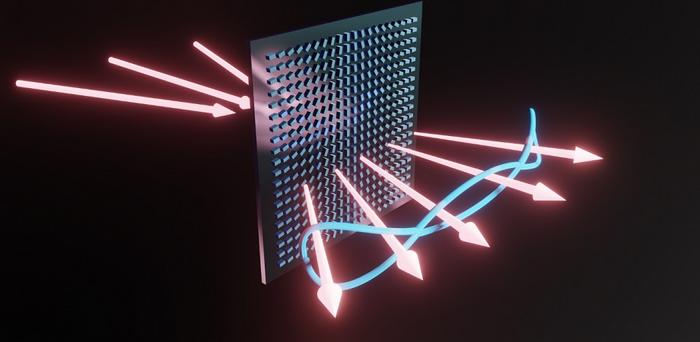In an ambitious stride towards revolutionizing quantum information processing, a collaborative team of researchers from prestigious institutions, including Peking University, Southern University of Science and Technology, and the University of Science and Technology of China, have unveiled a groundbreaking technique for generating multiphoton entanglement using a single gradient metasurface. This research, presented in the journal Advanced Photonics Nexus, holds immense potential for applications in quantum computing and communication, enabling more efficient manipulation of quantum states.
The world of quantum mechanics is often perplexing, governed by principles that defy classical logic. At the heart of quantum information science lies the concept of entanglement, which has profound implications for the transmission of information. The challenge often resides in the complexity and inefficiency of traditional methods, which involved intricate optical setups and mechanisms that are susceptible to loss and interference. Such complexities limited advancements in the development of scalable quantum networks and devices.
The pioneering work conducted by this research team involved a radical reimagining of the conventional approaches to generating entangled photons. Instead of relying on the cumbersome and often lossy nonlinear optical processes or elaborate setups involving beam-splitters and multiple quantum interference sources, the researchers utilized a single gradient metasurface to facilitate entanglement. This innovative approach enables the control of multiple single photons entering the metasurface from various angles, leading to a sophisticated interference pattern that results in the production of entangled photon pairs.
The implications of such a technique are vast. By enhancing the efficiency and reliability of photon entanglement generation, this method could serve as a central building block for future quantum networks. The researchers stated that their protocol allows for the creation of different types of entangled states and, importantly, enables the fusion of several pairs of entangled photons into larger entangled states. This advancement not only increases the amount of quantum information that can be compacted into a smaller physical footprint but also positions the metasurface as an integral component of compact quantum computing devices.
Professor Ying Gu, the leading author of the study, eloquently illustrated the transformative potential of this technology. He likened it to discovering a shortcut through a complex maze, where the traditional convoluted paths of quantum optics can now be navigated with relative ease using a single, elegantly designed element. This paradigm shift in the design of quantum information systems could facilitate the development of ultra-compact quantum devices that are feasible for integration into everyday technology, such as smartphones and laptops.
The quest for smaller, more efficient quantum devices is spurred by the insatiable demand for powerful computational resources and secure communication channels. As the world rapidly embraces the digital era, the intersection of quantum mechanics with information technology reveals a promising frontier. This new method for generating entangled photons could underpin a myriad of applications, from secure quantum communication protocols to innovative quantum algorithms that promise to perform tasks beyond the reach of classical computation.
Furthermore, entangled photons produced through this novel approach could pave the way for robust quantum networks capable of delivering secure information streams over significant distances. The capacity to generate and transmit entangled states to multiple users simultaneously heralds a new era in quantum communications, where security and speed become paramount. In such networks, quantum states can be distributed, shared, and manipulated, providing a foundation for future advancements in cryptography and secure information-sharing.
Ultimately, the findings discussed in this research empower the quest for integrating quantum technologies into practical applications. The versatility of metasurfaces offers the prospect of scalable solutions that can be deployed widely across various industries, ranging from telecommunications to healthcare. As researchers continue to explore the capabilities of these two-dimensional materials, exciting possibilities unfold.
The intricate balance required in quantum systems poses significant challenges, yet the innovative approach of utilizing metasurfaces as a single manipulative device could simplify the complexities associated with quantum entanglement. The journey toward exemplifying practical quantum devices is layered with obstacles, but with breakthroughs such as these, the path becomes increasingly navigable. The combination of technology and theoretical physics is set to yield transformative outcomes in the fabric of information technology.
As we embrace a future intertwined with quantum technologies, the insights from this research resonate deeply. With every advancement, we edge closer to harnessing the fundamental principles of nature for technological innovation. The synthesis of conventional optical approaches with modern nanotechnology reflects a significant evolution in our understanding and application of quantum phenomena. Researchers and engineers alike will undoubtedly continue to strive for breakthroughs that will redefine our technological landscape in the years to come.
Subject of Research:
Article Title: Multiphoton path-polarization entanglement through a single gradient metasurface
News Publication Date: 13-Feb-2025
Web References: https://www.spiedigitallibrary.org/journals/advanced-photonics-nexus/volume-4/issue-02/026002/Multiphoton-path-polarization-entanglement-through-a-single-gradient-metasurface/10.1117/1.APN.4.2.026002.full
References:
Image Credits: Credit: Peking University
Keywords
Quantum entanglement, Quantum information science, Photons, Metasurfaces, Quantum computing, Quantum information processing.
Tags: advanced photonics researchcompact optical devicesefficient quantum state manipulationengineered two-dimensional materialsentanglement in quantum mechanicsgradient metasurface technologymultiphoton entanglement generationphotonics and light manipulationquantum communication applicationsquantum computing advancementsquantum information processingscalable quantum networks





